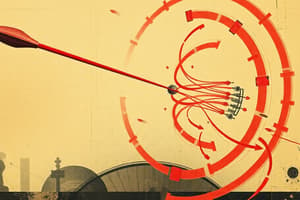Podcast
Questions and Answers
A ball is swung in a horizontal circle. Which force acts as the centripetal force?
A ball is swung in a horizontal circle. Which force acts as the centripetal force?
- Normal Force
- Friction
- Tension (correct)
- Gravity
A car is traveling around a circular track at a constant speed. What is the direction of the car's acceleration?
A car is traveling around a circular track at a constant speed. What is the direction of the car's acceleration?
- The car does not accelerate.
- Towards the center of the circle (correct)
- Opposite to the direction of motion
- Tangential to the circle
A ball is attached to a string and swung in a vertical circle. At what point in the circle is the tension in the string the greatest?
A ball is attached to a string and swung in a vertical circle. At what point in the circle is the tension in the string the greatest?
- The tension is the same at all points.
- At the bottom of the circle (correct)
- Halfway up the circle
- At the top of the circle
A ball is moving in a horizontal circle. The ball is suddenly released. What is the path of the ball immediately after it is released?
A ball is moving in a horizontal circle. The ball is suddenly released. What is the path of the ball immediately after it is released?
A car is traveling around a circular curve. If the car's speed is doubled, what happens to the centripetal force required to keep the car moving in a circle?
A car is traveling around a circular curve. If the car's speed is doubled, what happens to the centripetal force required to keep the car moving in a circle?
A ball is spinning inside a cone. If the ball spins too fast, what happens to the direction of friction?
A ball is spinning inside a cone. If the ball spins too fast, what happens to the direction of friction?
A ball is swung in a vertical circle. At what point in the circle is the tension in the string the least?
A ball is swung in a vertical circle. At what point in the circle is the tension in the string the least?
A satellite is in a circular orbit around the Earth. What provides the centripetal force that keeps the satellite in orbit?
A satellite is in a circular orbit around the Earth. What provides the centripetal force that keeps the satellite in orbit?
A ball is moving in a vertical circle. If the ball is moving too slowly at the top of the circle, what will happen?
A ball is moving in a vertical circle. If the ball is moving too slowly at the top of the circle, what will happen?
What is the relationship between the angular velocity (ω) and the period (T) of a rotating object?
What is the relationship between the angular velocity (ω) and the period (T) of a rotating object?
Flashcards are hidden until you start studying
Study Notes
Angular Velocity
- Angular velocity is the rate of change in angle with respect to time, measured in rad/s and symbolized by ω.
Periodic Time
- Periodic time is the time it takes for one full revolution to occur, measured in seconds and symbolized by T.
Centripetal Force
- Centripetal force is responsible for keeping an object moving in a circle, constantly changing direction.
- Sources of centripetal force include: • Tension • Weight • Reaction force • Friction
- Centripetal force always points towards the center of the circle.
Horizontal Circular Motion
- To solve problems involving horizontal circular motion: • Draw a force diagram for the object • Set vertical forces up and down equal to each other • Set total horizontal force equal to centripetal force • Combine equations and solve for unknowns
Friction
- To find the direction of friction, imagine which direction the object would move if the surface was smooth, and friction acts in the opposite direction.
- Examples: • Friction acts down and in if a ball is spinning too fast inside a cone and spirals up. • Friction acts up and out if a ball is spinning too slow inside a cone and spirals down.
Vertical Circular Motion
- The speed of an object in vertical circular motion is always changing as energy is converted between kinetic and potential energy.
- Conservation of energy must be used to solve problems involving vertical circular motion.
Strings and Tension
- Centripetal force in vertical circular motion comes from a combination of tension and a component of the object's weight.
- At the bottom of the circle, F = T - W, and tension is greatest.
- At the top of the circle, F = T + W, and tension is smallest.
- Tension in the string continuously changes, and if it reaches 0, the string goes slack.
- If a particle only just reaches the top, the string goes slack at that point.
Loops
- If a particle is moving along a loop, it feels a reaction force with the surface.
- To find when/where the particle falls off the loop, find when the reaction force becomes zero.
- If a particle is moving on a loop, the reaction force R acts in the opposite direction to the centripetal force.
- If a particle is moving inside a loop, R provides the centripetal force.
- Another way to find when a particle loses contact with the inside of a loop is to see when its speed becomes 0.
Studying That Suits You
Use AI to generate personalized quizzes and flashcards to suit your learning preferences.




